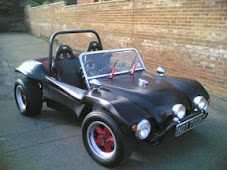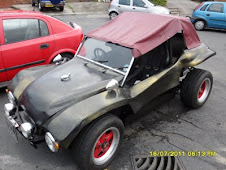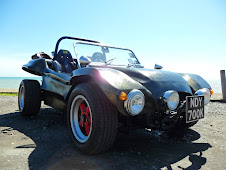.jpg)
OK before we start no Darth Vader or Daft Ader comments or wow that's an improvement. Caught in the act !
The day before I had spent the day looking around the buggy looking for jobs that needed to be completed before the M.O.T. This culminated with the front number plate being fastened to the bumper with self tapping screws and the formulation of the idea of a way to hold the battery in place as I had been recently told that the MOT regulation requires that the battery be able to stay in position with the vehicle upside down. I decided to sketch out some ideas that could be constructed from some angle iron. The premis was simple as i needed to have a bar across the battery and then some screws down each end that would hook into a base. The base could be constructed from a frame welded from 1" angle iron, the top from 1/2 angle iron and the securing bolts from 6mm steel rod.
I cut the 1" angle iron with an angle grinder so that I had one of the angles removed and a flat piece of steel about 6" long. The end I made up from 5" of angle iron and drilled a hole in the centre to take the bolt. I new this would needing welding and only had my trusty Sealey Mig 100XT to weld it as my Arc welder was at my fathers. I had not used the Mig for a while so as with all Mig welders it needed a clean up before I attempted to weld with it. The welding material was rusty and this had to be removed until clean material was available and the tensioner had to be adjusted. You should never attempt to weld with a
.jpg) MIG welder that has rusty wire as it can block up the welder and causes the mechanism to slip as the rust acts as a lubricant.
MIG welder that has rusty wire as it can block up the welder and causes the mechanism to slip as the rust acts as a lubricant.I welded the framework up easily welding both sides of the frame to provide
.jpg) a good weld. This made a nice solid base and I finished the welding on the first end and was soon onto the other end. I am glad I cleaned up the MIG as it was performing beautifully and creating good solid welds on the Angle Iron. You can see in the picture opposite that the base of the battery compartment was taking shape. I cleaned the welds up with my Angle Grinder and packed the welding equipment away and returned to the garage.
a good weld. This made a nice solid base and I finished the welding on the first end and was soon onto the other end. I am glad I cleaned up the MIG as it was performing beautifully and creating good solid welds on the Angle Iron. You can see in the picture opposite that the base of the battery compartment was taking shape. I cleaned the welds up with my Angle Grinder and packed the welding equipment away and returned to the garage.Now you may ask why I welded at my house when most of you are aware that I have a 2.7KW Honda Generator, the trouble is the MIG seems to use about 2.8kw at peak and the welder trips out. I will have to service the generator at some point and try this again as most information on the net says this combination should
.jpg) work.
work.In the garage I heated up the rod ends and bent them over in a vice. I took the battery out of the buggy and placed it on top of my frame. This gave me a height that my screws would have to be. I cut the rod down to this length plus one inch and then tapped tapped a thread on each with a 6mm metric die. The bar was cut to length and the rods could be inserted. I drilled the base so that it could be fixed to the fibre glass.
The frame looked great and I took it back to the house with the in tension of taking it to my Zinc plater AC Blastings, who provide a hot Zinc spray process. This would take a while and I intended to get it to them on Monday.
.jpg)





















